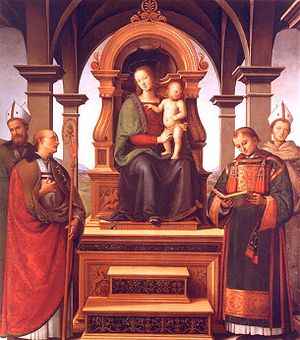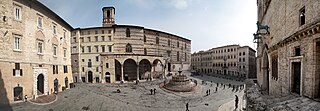
Perugia is the capital city of Umbria in central Italy, crossed by the River Tiber, and of the province of Perugia. The city is located about 164 km (102 mi) north of Rome and 148 km (92 mi) southeast of Florence. It covers a high hilltop and part of the valleys around the area. The region of Umbria is bordered by Tuscany, Lazio, and Marche.
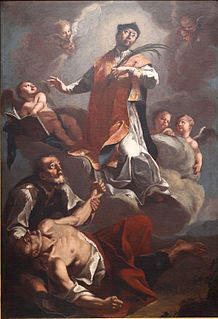
Saint Valentine was a 3rd-century Roman saint, commemorated in Western Christianity on February 14 and in Eastern Orthodoxy on July 6. From the High Middle Ages, his Saints' Day has been associated with a tradition of courtly love. He is also a patron saint of Terni, asthma and beekeepers. Saint Valentine was a clergyman – either a priest or a bishop – in the Roman Empire who ministered to persecuted Christians. He was martyred and his body buried at a Christian cemetery on the Via Flaminia on February 14, which has been observed as the Feast of Saint Valentine since at least the eighth century.

Saint Lawrence or Laurence was one of the seven deacons of the city of Rome under Pope Sixtus II who were martyred in the persecution of the Christians that the Roman Emperor Valerian ordered in 258. Lawrence encountered the future Pope Sixtus II, who was of Greek origin and one of the most famous and highly esteemed teachers, in Caesaraugusta. Eventually, both left Spain for Rome. When Sixtus became the Pope in 257, he ordained Lawrence as a deacon, and though Lawrence was still young appointed him first among the seven deacons who served in the cathedral church.

Blaise of Sebaste was a physician and bishop of Sebastea in historical Armenia who is venerated as a Christian saint and martyr.
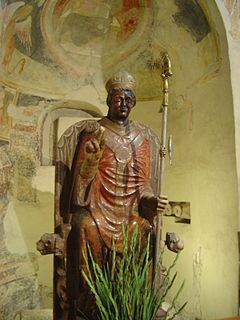
Zeno of Verona was either an early Christian Bishop of Verona or a martyr. He is a saint in the Roman Catholic Church and in the Orthodox Church.
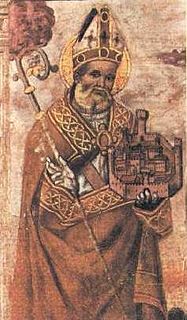
Ubald of Gubbio was a medieval bishop of Gubbio, in Umbria, today venerated as a saint by the Catholic Church. Saint Ubaldo Day is still celebrated at the Basilica of Sant'Ubaldo in Gubbio in his honor, as well as at Jessup, Pennsylvania.

Herculanus of Perugia was a bishop of Perugia. He was canonized as a saint by the Catholic Church and is recognised as patron saint of Perugia. His main feast day is November 7; his second feast is celebrated on March 1. According to Pope Gregory the Great in his Dialogues, Herculanus suffered martyrdom when Totila, king of the Ostrogoths, captured Perugia in 549.

Our Lady of Graces or Saint Mary of Graces is a devotion to the Virgin Mary in the Roman Catholic Church. Several churches with this dedication often owe their foundation to thankfulness for graces received from the Virgin Mary, and are particularly numerous in Italy, India, Australia, United States, Portugal, France and the Italian-speaking region of Switzerland. Also it is related to the Marian apparitions in which was revealed the Miraculous Medal, also known as the Medal of Our Lady of Graces.

Saint Felician(us) of Foligno is the patron saint of Foligno.

Foligno Cathedral is a Catholic cathedral situated on the Piazza della Repubblica in the center of Foligno, Italy. The cathedral, built on the site of an earlier basilica, is dedicated to the patron saint of the city, the martyr Felician of Foligno, who was buried here in 251 AD. It is the seat of the Bishop of Foligno. It contains the cathedra for the Diocese of Foligno.

Saint Chiaffredo is venerated as the patron saint of Saluzzo, Italy. Tradition considers him a member of the Theban Legion, but instead of being martyred with this legion at Agaunum, he escaped to Piedmont and was martyred there.
Simplicius, Constantius and Victorinus are venerated as Christian martyrs of the 2nd century. Simplicius, was, according to tradition, a Christian of the Abruzzi region who was executed along with his two sons, Constantius and Victorian, during the reign of Marcus Aurelius. Their Passio contains all of the tropes of the genre. It is believed that the martyrdoms are genuine but that the three martyrs were not necessarily related to one another, but were executed together at Marsica.
Saint Magnus of Cuneo is venerated as a martyr and member of the legendary Theban Legion. The center of his cult is situated at the mountain sanctuary known as the Santuario di San Magno, in the Valle Grana, Castelmagno, in the province of Cuneo. His feast day is August 19.

Saint Constantius is venerated as a member of the legendary Theban Legion. Similar to the cults of Saint Chiaffredo at Crissolo, Saint Bessus at Val Soana, Saint Tegulus at Ivrea, Saint Magnus at Castelmagno, and Saint Dalmatius at Borgo San Dalmazzo, the cult of Saint Constantius was linked with that of the Theban Legion to lend antiquity to a local saint about whom nothing was really known.
Saint Crispoldus is venerated as a 1st-century Christian martyr. He is the patron saint of Bettona, in Umbria, and said to have been the first bishop of that city, although the dioceses of Nocera and Foligno also include his name in episcopal lists.
Saint Pelinus or Pelinus of Brindisi was a Basilian monk, later bishop of Brindisi in Italy, martyred at Corfinio and made a saint in 668. His feast day is Dec. 5.
Constantius was a Bishop of the Catholic Church who, after many years wandering, became the patron saint of Capri.
Giacinto Boccanera (1666-1746) was an Italian painter.

Anton or Antonio Maria Fabrizi or Fabrizzi was an Italian painter, active in Perugia and Foligno in a Baroque style.

San Ponziano is a romanesque-style, Former-Benedictine monastery and church located in Spoleto, Province of Perugia, region of Umbria, Italy. The site is dedicated to St. Ponziano, the patron saint of Spoleto.
